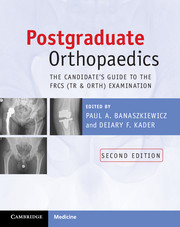Book contents
- Frontmatter
- Contents
- Contributors
- Foreword
- Preface to second edition
- Abbreviations
- Section 1 The FRCS (Tr & Orth) examination
- Section 2 The written paper
- Section 3 The clinicals
- Chapter 3 The short cases
- Chapter 4 The intermediate cases
- Chapter 5 Shoulder and elbow clinical cases
- Chapter 6 Hand and wrist clinical cases
- Chapter 7 Spine clinical cases
- Chapter 8 Hip clinical cases
- Chapter 9 Knee clinical cases
- Chapter 10 Foot and ankle clinical cases
- Chapter 11 Paediatric clinical cases
- Section 4 The adult elective orthopaedics oral
- Section 5 The hand oral
- Section 6 The paediatric oral
- Section 7 The trauma oral
- Section 8 The basic science oral
- Section 9 Miscellaneous topics
- Index
- References
Chapter 11 - Paediatric clinical cases
from Section 3 - The clinicals
- Frontmatter
- Contents
- Contributors
- Foreword
- Preface to second edition
- Abbreviations
- Section 1 The FRCS (Tr & Orth) examination
- Section 2 The written paper
- Section 3 The clinicals
- Chapter 3 The short cases
- Chapter 4 The intermediate cases
- Chapter 5 Shoulder and elbow clinical cases
- Chapter 6 Hand and wrist clinical cases
- Chapter 7 Spine clinical cases
- Chapter 8 Hip clinical cases
- Chapter 9 Knee clinical cases
- Chapter 10 Foot and ankle clinical cases
- Chapter 11 Paediatric clinical cases
- Section 4 The adult elective orthopaedics oral
- Section 5 The hand oral
- Section 6 The paediatric oral
- Section 7 The trauma oral
- Section 8 The basic science oral
- Section 9 Miscellaneous topics
- Index
- References
Summary
Introduction
The aims of the FRCS exam are to see if you have enough knowledge to become a consultant orthopaedic surgeon and be able to practise safely; not to test you as a paediatric orthopaedic consultant. Examiners appreciate that not all candidates have done paediatric training; nevertheless, they expect them to have a sensible approach to tackle the common paediatric orthopaedic problems that can face any orthopaedic surgeon in their daily practice. Candidates who have had training in paediatric surgery found the paediatric orthopaedic section relatively easy; however, those who did not found it extremely stressful and some actually failed it. We strongly advise candidates who did not have the opportunity to do a paediatric orthopaedic job to attend a few paediatric orthopaedic clinics in their institute or a nearby centre to become familiar with common scenarios and their assessment and management. In this section, there is a series of clinical cases that have appeared in the FRCS (Tr & Orth) exams over the past 5 years with comments on candidates' experience. This section should be read in conjunction with the paediatric core knowledge chapter and these should cover most of paediatric section syllabus.
Klippel–Feil syndrome
This can present in adult or child. There is a short webbed neck or no neck appearance with low hairline.
- Type
- Chapter
- Information
- Postgraduate OrthopaedicsThe Candidate's Guide to the FRCS (Tr and Orth) Examination, pp. 127 - 148Publisher: Cambridge University PressPrint publication year: 2012



